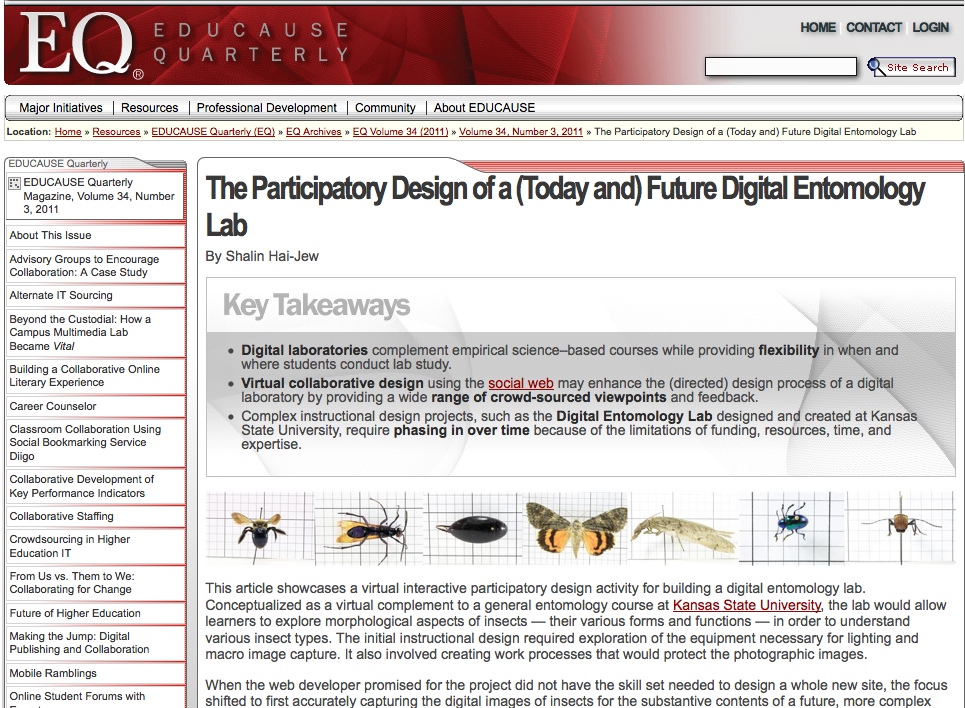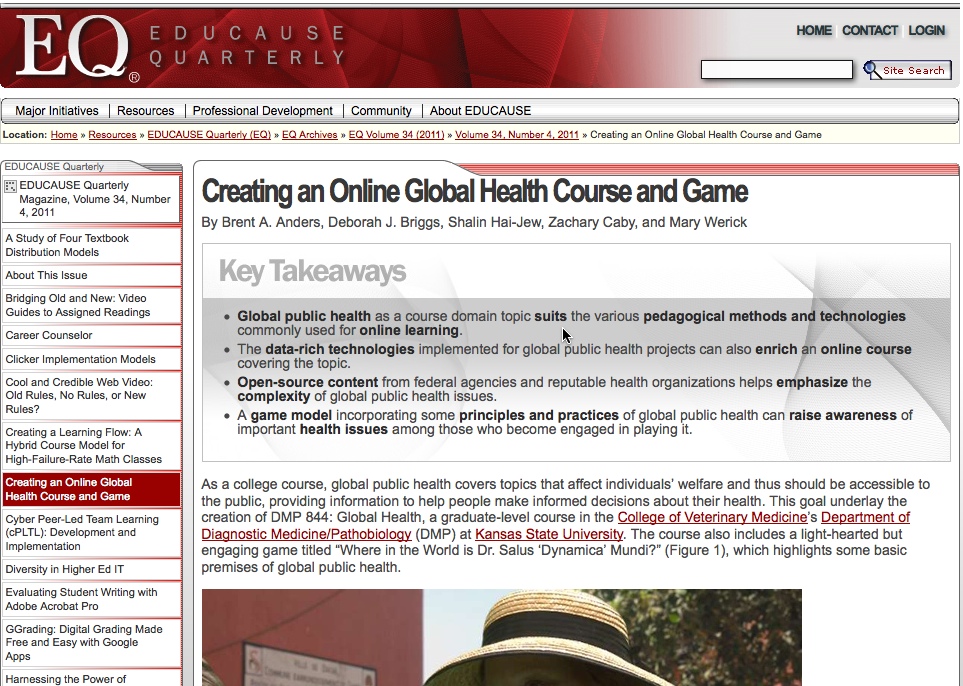Have you ever wished an article you were reading (or writing) was more interactive? Of course you have! Well today we’re sharing a behind the scenes interview with an interactive article guru who happens to be our most recent Innovator, Shalin Hai-Jew, an Instructional Designer from Kansas State University. Get the full scoop on interactive articles below.
What is an “interactive article”?
Interactivity is about a kind of give-and-take between readers, the writer(s), and the content in the interactive article.
I think of v.1 or traditional academic articles as text-based and fairly linear and sequential. If there are images, they are b/w and 2D based. Online articles (v.2) are those that may include some hyperlinks to sources, and these may have color or even more sophisticated imagery. I think of “interactive articles” (v.3) as those that integrate a range of interactivity (immersive games, experiential photo albums or slideshows, interactive maps and timelines, 3D visuals, simulations, and wiki and blog augmentation). These types of articles have only been enabled with the advances in the Internet and the authoring tools to enable people to create various types of contents.
Such interactive articles actively elicit participation from the audience and integrates that into the article and related projects. This opens up possibilities for enriched reading and innovation experiences.
Why should educators consider transforming a traditional academic article into an interactive article?
Interactive articles enable an author or an authoring team to create a rich reader experience—to compete for their attention with engaging content and reading / learning opportunities. Authors are able to engage multiple audiences simultaneously.
Individual authors and authoring teams that are sufficiently situated to create such interactive articles should give this a whirl. Creating these offers cool opportunities to collaborate and to raise awareness of the project. However, I will say that these do involve a fair amount of work.
What are the specific features of an interactive article that most benefit the reader?
That’s a great question! I think different parts of an article have different salience for different readers. Digital contents are shaped and targeted to a certain readership, and when that connection is created correctly, then sometimes certain features spark.
My favorite parts of interactive articles have to do with data visualizations and analytics. Those may be integrated using various public tools or software, and they are part of the narrative of the article. I also like parts that force tougher analysis—like case studies or simulations or complex games (which have one guessing at the algorithms on the back end).
Can you explain what it means to go beyond hyperlinking to immersive “extreme layering” and more complex and integrative experiences?
To me, I think of interactive articles with “extreme layering” of experiences to be those that are more demanding (and yet more supportive) of readers. One aspect of a layer could be a storytelling structure that encapsulates the learning. There can be mysteries or problem-solving aspects to an interactive article. Maybe virtual readers are asked to collaborate around design features (see the “Participatory Design” article link at the end). Or there may be an outdoors aspect to an article, which uses mobile devices in “augmented reality” real spaces.
There are ways to build sort of a macro-level scaffolding of ideas to engage readers…and with the mix of technologies, various authoring tools may create certain integrative effects that enrich the learning. SoftChalk 7 is one of those tools that really expands the toolkit for the creation of such contents and delivering it in a way that coheres. Another benefit is that it enables the building of accessibility (with alt-tagging of images and the ability to include transcripts of video and audio files, for example) into the digital objects and experiences. So one can go multi-sensory while maintaining the informational value of the interactive experiences.
Why is it important to manage expectations when creating an interactive article?
For people who’ve never gone public with a publication before, there are usually outsized expectations of what publishing will do for their lives. Publishing is only publishing. It involves some risks if people aren’t careful about intellectual property, proper discretion, and privacy protections. Authors have to be very fastidious about documentation and rights releases. Of course, with open-source resources and Creative Commons and GNU licensures, a lot more is out in the world with generous releases (for articles that may also be open-source).
In addition, the process of working with various editors, publishers, and peer reviewers can be very challenging especially for those who have a huge reputation to protect (never a good idea) or a huge ego on the line (an even worse idea).
What steps should be taken to create an interactive article and what components are critical to the creation of the interactivity?
An article is all about having a logical and coherent structure and smooth transitions. That’s all easier said than done particularly in a digital environment which offers so many opportunities for jumping from one concept or experience to another. The transitions have to be smooth but also fit the digital realm, so it’s not like you’re just transferring v.1 standards to interactive articles. In the presentation “Building Interactive Articles for Peer Reviewed Journals with SoftChalk 7 on Feb. 22, I focused on nine steps.
- Inspiration and Vision
- Political Environment
- Available Resources
- Topic Suitability for an Interactive Article
- Planning and Execution
- Alpha and Beta Testing
- Shopping the Digital Manuscript
- Addressing Peer Reviews
- Revision and Launch
As for components critical to the creation of the interactivity, that depends a lot on what one is trying to convey…and the context of the article. The point is to highlight important ideas or knowledge or skills with digital experiences. It’s all about the value-added part. Sometimes, it may make sense to create a virtual team to try to co-design something. Other times, it may make sense to build an immersive game. Maybe a digital story is the right way to approach interactivity in another circumstance. This is all about having the “right” components that may be created given the practical limits of the team and the interactive article topic and the workplace context.
Please share with us some examples of the interactive articles you have published.
- “Creating an Online Global Health Course and Game” by Brent A. Anders, Deborah J. Briggs, Shalin Hai-Jew, Zachary J. Caby, and Mary Werick
- “The Participatory Design of a (Today and) Future Digital Entomology Lab” by Shalin Hai-Jew
Shalin’s Innovator presentation, “Building Interactive Articles for Peer Reviewed Journals with SoftChalk 7″ occurred on Feb. 22.
Click here to view the webinar recording. / Click here to view the Prezi Presentation.



2 Comments
Publishing Interactive Articles – An Interview with Shalin Hai-Jew | Marathon Learning Materials Ltd
[…] Designer from Kansas State University has outlined some of the issues in this area – Read the full article Back to […]
Imran Soudagar
Thank you for the interactive article related to publishing. Will be useful to me. Specially I liked the 9 steps which you have mentioned.